Sleeping Giant Provincial Park, Ontario, Canada
The name of the Lord is a strong fortress; the godly run to Him and are safe. Proverbs 18:10
FYI – we’ve been out of internet service for nearly a week at the time of this posting. We are now in a place where we can get it, but it’s so weak, it takes at least a minute to upload each picture. Sigh . . . .

This is our morning view today!
Maybe a bear will walk out of there . . . .
Our campground is actually on Marie Louise Lake. It’s a relatively large lake but I couldn’t find anything to tell you how large. We aren’t directly on it, we’re across the street, but some sites are, and we can see dots of it through the trees.
Today, we visit seven different locations within the Park, plus another stop at the Visitor Center to talk with them about tomorrow’s plans.
Up first, Joe Creek.
Yep. We went up the creek without a paddle. 😊
This was a 1.5 mile round trip hike that was supposed to lead to Lake Superior. Along the way, we encountered terrific waterfalls, which was good, because the end of the trail was not so great. Yes, we saw the Lake, but only through trees. There really wasn’t a good viewing spot. The trail just kinda . . . . ended . . .



This is the first waterfall.
We caught the other one on the way back.
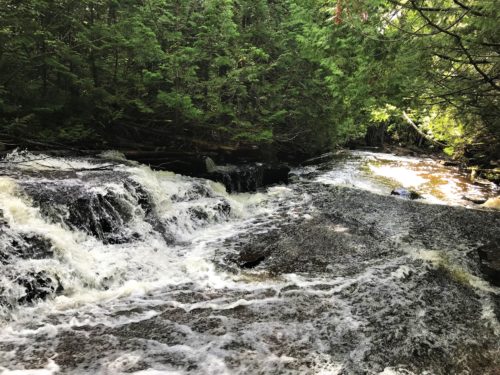





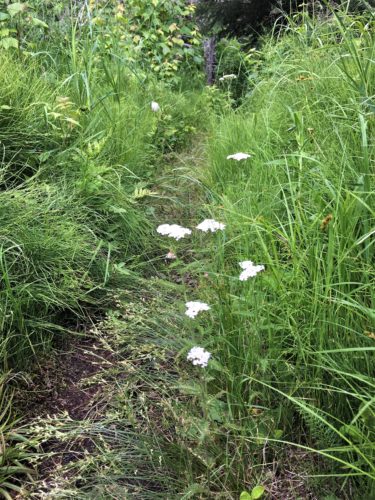


There’s the view!
The brown is from the river running in to the bay.


On the way back.

This is the other waterfall.



The only other people we saw was a very pregnant couple from Nebraska.
Oh! And when we parked, the Jeep’s outdoor temperature reading was sixteen degrees!
Celsius. 😊 In Fahrenheit, it was 60.
Next on our list, was a drive to the Thunder Bay Lookout. The Ranger yesterday told us that it’s 9kms of Jeep-worthy road, and they don’t recommend cars, etc. on it. We were pretty excited about that prospect! Of course it was nothing like what we did in Tennessee, but it was pretty rough.
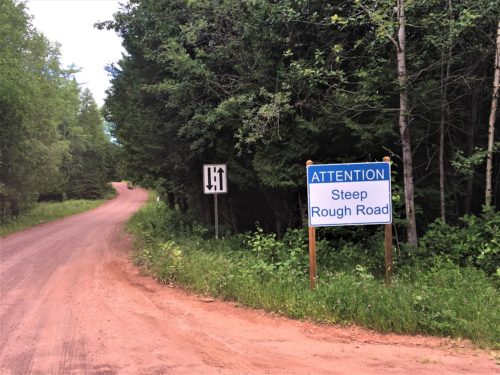

We did a couple of detours along the way to the overlook. The first was Lizard Lake. It was a pretty little lake, complete with a picnic table. We examined it for potential paddling, and thought – maybe.


Jeep commercial! : )


The other stop was at Pounsford Lake. This one looked more fun for kayaking. It was larger and had several islands to paddle around, in addition to a great put-in spot. But not today.


On to the overlook. When we arrived, we were shocked speechless, with mouths agape, to see a Class-C motorhome sitting there! No way they should’ve driven that up here!

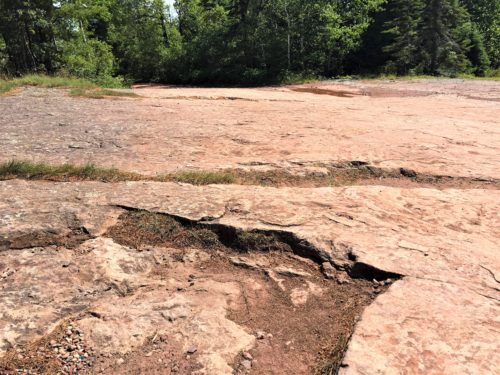
It was a great knee-melting overlook! 100 meters, which translates to 328.084 feet. Trust me . . . it was really high!








We met a family out there who were from Toronto. During our brief conversation, we exchanged local colloquialisms (How’d ya like that big word I used? 😊) – the way Canadians always say, “Aye” at the end of their sentences, and many Ohioans, when told “Thank you”, say “Yep”, instead of “You’re welcome.”
On the way out, we returned to Lizard Lake for an exhilarating lunch – what with the scenery, a nice breeze against our skin and being completely isolated, it was practically perfect!

We had read this description in a trail guide the Park provided: Scenic white pines are scattered along this winding trail that emerges at Sifting Lake, a thriving beaver habitat. 2.7 miles round trip. Now doesn’t that sound wonderful? It wasn’t. There was lots of muck, and the view was a bust. All that walking for next to nothing. And there were zero beavers. Just some long-ago apparently beaver-cut trees laying there. Sigh . . .


This fire is called Fireweed.
We first encountered it in Alaska.
It blooms from bottom to top and Alaska legend has it that once it gets to the top, it’s only 6 more weeks until winter!
Wonder if it’s as accurate as Punxsutawney Phil?



Muck

And more muck . . .
but at least there’s a pretty reflection in the water.


I think something got tired of listening to this blue jay.


And here’s what we hiked 2.7 miles for.
And not even any beavers. : (
The Ranger told us to be sure to drive to the town of Silver Islet, so we did. What a cute little town! Beautiful!


Both these houses are using solar panels.


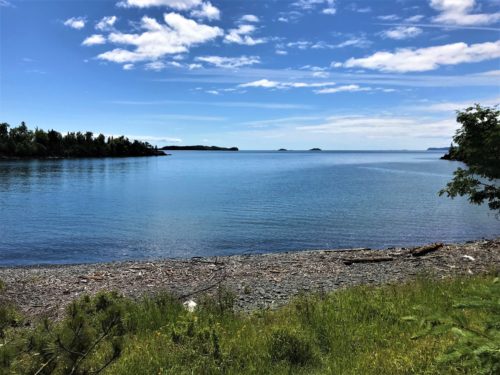

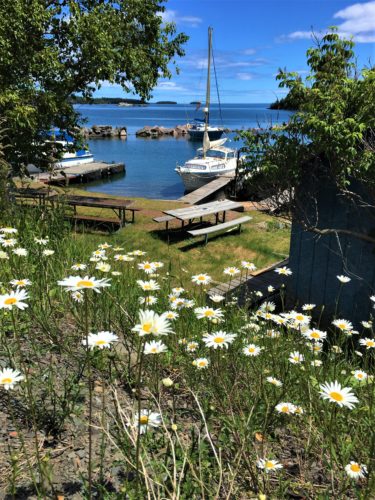

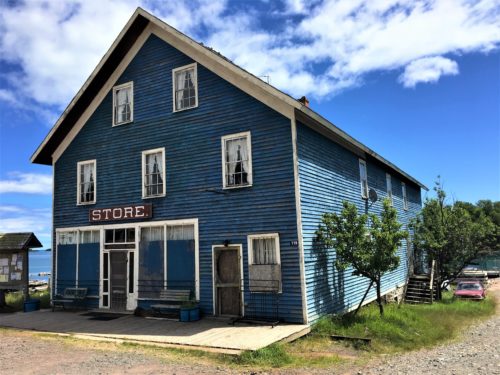
The general store

An old house we know nothing about.


These houses have no yards. They butt up against the street and behind them is a rock cliff.
But across the street is gorgeous!!







I felt the need to do some research on this town after reading the plaque about it being a former silver mining town – especially since that was so long ago.
Silver Islet is another of Ontario’s best kept ghost towns. It is also one of the oldest. A one-time silver mining town on the shores of Lake Superior, a huge deposit of silver was discovered around 1845. There was no easy access to the silver ore deposit for it was located on a small shoal under a limestone mesa called Thunder Cape. Initial efforts to mine the ore all proved futile. It was as though the volatile weather of Lake Superior was to deny entrance to the ore deposit for all time to come. Several decades later the battle was joined when a new owner acquired the property. Several breakwaters were built to contain the fury of the lake’s waters. They, too, were demolished by storms, ice surges, and even a freak tidal wave. Finally, a breakwater of rock and concrete was built that allowed miners to extract silver ore worth $3 million. In 1883, mining operations ceased for lack of fuel (coal) for the furnaces and water filled the shafts. ~ Henry Chenoweth
There were no mining safety standards and every day the miners worked with the fear that their head candles would set trapped pockets of gas on fire. As the company extended the mine shaft deeper and deeper under Lake Superior, the terror the miners’ felt at being lowered beneath the lake increased with the depth of the shaft. Only a flimsy wooden and stone wall separated the miners from Lake Superior and the waves constantly battered it. By late October 1873, the shaft had reached a depth of nearly 300 feet under Lake Superior and for the first time, water entered the shaft when a vein opened into a crevice from the lake. The shaft began to fill at a rate of about ten feet an hour and the miners fled for their lives. Then two heavy storms struck within days of each other, doing about $10,000 worth of damage to the cribs and break walls.
Despite the danger, discouragement, and disasters, the men worked the Silver Islet mine enthusiastically and successfully for many years. The silver ore they mined the first two or three years consisted of “packing” type ore, rich enough for the company to ship it away in sacks and barrels for smelting. Some of the “packing ore” brought $7,000 per ton. Frequently the men found nuggets of pure silver and in 1873, they extracted nearly $550,000 in silver and they also mined 20,000 tons of rock, worth $40 to $50 a ton to be crushed in the stamp mill.
By 1883, miners had extracted the highest quality silver and the price of silver had declined. The Silver Islet Mining Company and the Silver Islet Consolidated Mining and Lands Company had expanded the original 90-foot island ten times its size and by 1883, one of its shafts reached 1,250 feet, nearly a quarter of a mile deep.
The Silver Islet mine had been one of the richest silver mines in the world. People considered it a marvel in modern mining and at one point the stock had sold readily at $1,500 above par value. Many mammoth silver nuggets had come from Silver Islet mine, some so pure they didn’t need smelting and in over thirteen years of operation, it had yielded approximately 3.25 million dollars’ worth of silver, $1,300,000 in its first three years alone. ~ excerpts taken from Magic Masts and Sturdy Ships.com
Driving back towards home, we stopped at the Plantain Lane trail. This one was described as one of the park’s many treasures. It was a really short walk to a bridge that overlooks Sibley Creek. This description was correct. 😊




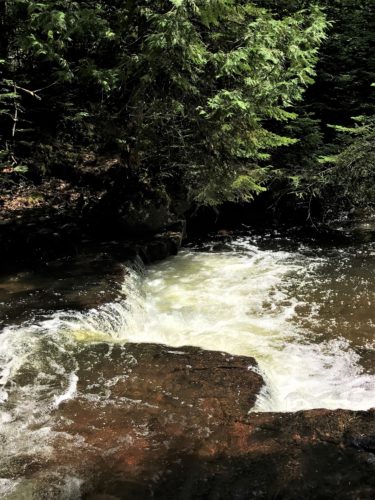



Very nice day! It ended a little early, but we need to rest up for tomorrow!
